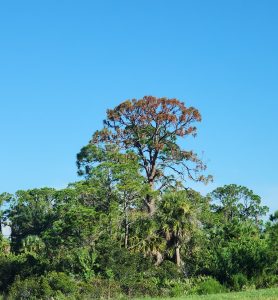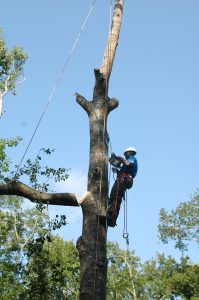Florida is no stranger to the powerful forces of hurricanes that sweep through its landscapes, leaving devastation in their wake. Hurricane Idalia, Ian, and Irma have all drastically impacted our local landscapes in recent years. While immediate attention is often focused on the visible damage (ex. uprooted trees, down limbs, etc.) caused by these storms, a silent struggle unfolds in the months that follow. Our pine trees, standing tall and seemingly unscathed, bear a largely invisible burden after hurricanes. In this blog post, we delve into the hidden impact of hurricanes on Florida pine trees, exploring how wind damage sets the stage for their eventual demise, exacerbated by opportunistic insect infestations.

The Resilient Exterior
Florida is home to a variety of pine tree species, such as longleaf pines (Pinus palustris) and slash pines (Pinus elliottii). These native pines, characterized by their tall trunks and evergreen needles, are vital components of Florida’s ecosystems.
In the immediate aftermath of a hurricane, these pine trees may appear surprisingly resilient. Unlike many other trees, their branches often suffer minimal damage, and they remain standing tall. However, this outward resilience belies the silent battle that may be waging beneath the surface.
Sensitive Root and Vascular Systems
One of the lesser-known facts about Florida pine trees is that their root systems are extremely sensitive. This is why you rarely see pine trees survive construction/heavy machinery in their vicinity. Outside of their taproot, their roots typically extend only a few feet below the soil surface, making them vulnerable to physical damage.
When a hurricane sweeps through a forest, it brings with it powerful gusts of wind that can loosen the soil around the trees’ shallow root systems. Also, the twisting and bending the canopy experiences harms the vascular system of the tree, limiting the trees’ ability to heal after the storm. This separation of vital vascular tissue is called the “ring shakes.” Even if the trees remain upright, their internal systems can be severely damaged, compromising their ability to absorb water and essential nutrients from the soil. This damage might not manifest immediately, but it sets the stage for a slow death that may play out over the course of a year or more.

The Slow Decline
In the months following a hurricane, many Florida pine trees quietly begin to deteriorate. The initial shock and stress of the storm weakened the trees, causing them to struggle with growth and overall health. Their compromised biological systems make it challenging to access the resources needed to thrive. Visually, impacted trees start to look like they are dying the summer following the hurricane. Needles start to turn from green to yellow to reddish brown. An early sign of attack includes the accumulation of reddish-brown boring dust on the bark (EDIS Pub #EENY-388).
Pine trees that have sustained root and vascular damage become more susceptible to diseases and pests, particularly pine beetles. These insects are naturally occurring in Florida’s ecosystems but can be kept in check by healthy, resin-producing trees. However, when hurricane-damaged trees can no longer produce sufficient resin to repel pine beetles, these opportunistic pests move in, hastening the trees’ decline.
Pine Beetles: Opportunistic Pests
Non-epidemic pine beetles are well-adapted to take advantage of weakened trees. When a tree’s health is compromised, it loses its ability to fend off these invaders effectively. Fortunately for us, the “epidemic” pine beetle species, the Southern Pine Beetle (Dendroctonus frontalis), has never been observed in the southern half of Florida. So, we currently do not need to worry about beetles spreading from an infected tree to healthy trees.
Instead, the non-epidemic pine beetles burrow into the bark of hurricane-damaged pine trees, laying eggs that hatch into larvae. These larvae feed on the inner tissues of the tree, further disrupting its vascular system and ultimately leading to its demise. Remember, these pine beetles are a natural part of Florida’s ecosystems, the initial hurricane damage just creates an opening for them to thrive and multiply. This mass pine die-off isn’t all bad. One silver lining is that many birds, such as woodpeckers, rely on dead trees for the insects they host and the nesting opportunities they provide. So, if the dead pine snags are away from areas frequented by humans, leaving them standing has a myriad of wildlife benefits.

What to do if you think your pine tree has beetles?
As with all pest management, the first step is to correctly identify the pest to determine the best course of action. If your landscape pine trees are impacted and/or on the decline, you should invite a certified arborist out for a site inspection to evaluate the tree. Unfortunately, if it’s determined that your pine tree has a beetle infestation, there is no treatment that will save the tree. As mentioned earlier, the presence of beetles is secondary to the main tree decline since the beetles are attracted to decaying wood.
If the tree is not a risk to a structure or activity area, you may consider leaving the pine to serve as a snag that will provide food and nesting habitat for many birds, such as woodpeckers and owls. A certified arborist can help determine whether the tree poses a risk and should be removed.
A tree permit may be required by your municipality to remove a tree. For Sarasota County residents, contact the Environmental Protection Division at 941-861-5000 to confirm whether a tree permit is required prior to removal.
Declaration of Generative AI and AI-assisted technologies in the writing process
During the preparation of this work, the author used ChatGPT in order to help build out the blog post. After using this tool/service, the author reviewed and edited the content, and takes full responsibility for the content of the publication.
Resources:
- Pine Bark Beetles of Florida
- Arborist Lookup
- My pine is under attack—what should I do? A primarily insect-based decision-support guide for pine death management.
- Is my tree safe? Recognizing conditions that increase the likelihood of tree failure.
- Assessing Hurricane-Damaged Trees and Deciding What to Do
- Get the Right Tree Care Professional
- EENY-388/IN701: Ips Engraver Beetles, Ips spp. (Insecta: Coleoptera: Curculionidae: Scolytinae) (ufl.edu)
Source: UF/IFAS Pest Alert
Note: All images and contents are the property of UF/IFAS.



